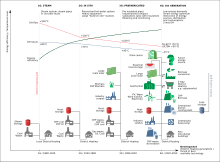Central heating

A central heating system heats a building from one main source of heat. There may also be ventilation, and air conditioning which can cool the building.
A central heating system has a furnace or boiler that uses fuel or electricity to heat water or air. Heated air is pumped through through ducts. Steam or hot water is pumped to radiators. The fuel may be coal or wood, oil, kerosene, natural gas, or electricity.
Central heating gives better temperature control in a building.. Large buildings may be divided into smaller parts with their own temperature controls.
Before the general use of central heating in most homes there would be a fire in one room and the whole family would be there in the evening. With central heating people can use the different parts of the house. In 1965 a British Gas advertisement said that central heating “turns bedrooms into playrooms”.[1]
Overview[change | change source]
In much of the temperate climate zone, central heating started to be fitted since before the Second World War. Coal-fired steam or hot water systems were common. More recently fuel oil or gas has been used more. Electrical heating systems are generally more expensive. Heat pumps are now being installed as they are cheaper and produce less greenhouse gas. .[2]

Some buildings have central solar heating usually connected to radiators. Gas heaters and district heating are other possibilities. District heating uses waste heat. It need underground piping to circulate hot water or steam.
History[change | change source]
In ancient Korea, Greece and Rome some buildings had under-floor heating. This system is called a hypocaust. [3] Some later monasteries had them. They were also used in the Byzantine and Ottoman Empires and in the Baltic region.[4]
References[change | change source]
- ↑ "How central heating changed everything about our homes". www.ft.com. Retrieved 2024-03-22.
- ↑ "energy.og – Electrical Resistance Heating". Retrieved 2015-01-15.
- ↑ "The Hypocaust". St Albans Museums. Retrieved 2024-03-22.
- ↑ Decker, Kris De (2017-03-17). "Heat Storage Hypocausts: Air Heating in the Middle Ages". LOW←TECH MAGAZINE. Retrieved 2024-03-22.
